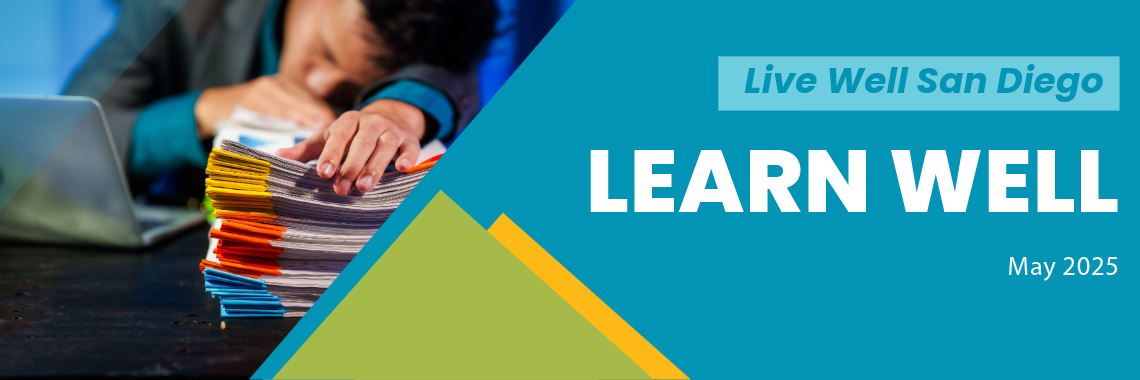
By: Samantha Mendoza, Graduate Student Worker, Live Well San Diego Support Team
Employee burnout is a state of emotional, physical, and mental exhaustion resulting from prolonged or excessive exposure to workplace stressors. It is typically characterized by three key dimensions: exhaustion, cynicism, and reduced professional efficacy. Burnout can lead to feelings of depletion, detachment from work, and a general sense of ineffectiveness. It often occurs when individuals face chronic workplace stress without adequate support or coping resources. This is why it is crucial for employers to recognize the signs of burnout and take proactive steps to help employees manage stress and prevent burnout.
Why is it important?
According to the National Alliance on Mental Illness (NAMI), half (52%) of employees reported feeling burned out in the past year due to their jobs, and 37% said they felt so overwhelmed that it affected their ability to do their work (NAMI, 2024). Burnout is a serious occupational health issue with significant negative consequences for individuals, organizations, and society as a whole. Several factors can contribute to employee burnout, including work overload, unfair treatment, and lack of role clarity.
Work overload can lead to physical, mental, and emotional exhaustion over time. Physically, an individual may experience fatigue and a weakened immune system, increasing their susceptibility to illness and resulting in more frequent absences from work. These absences can reduce productivity and work quality, which may, in turn, lead to feelings of anxiety and depression as employees struggle to meet expectations.
Unfair treatment, such as favoritism or unequal distribution of workloads, also contributes to burnout by creating a toxic work environment. When employees perceive that they are being treated unfairly, it can erode trust in leadership, colleagues, and the organization. This sense of injustice can increase stress and emotional exhaustion, and make employees feel that their well-being and career are at risk.
Lack of role clarity is another major contributor. When employees are uncertain about their responsibilities and expectations, it can lead to confusion, stress, and job dissatisfaction. This uncertainty may result in decreased productivity, misunderstandings, and conflict. In some cases, employees may compensate by working longer hours, which can contribute to fatigue and negatively affect their mental health.
Symptoms of Burnout
Burnout manifests in physical, emotional, and behavioral ways. Common symptoms include chronic exhaustion, increased mental distance from work, and reduced professional effectiveness. Other signs may include sleep disturbances, changes in appetite, physical complaints such as headaches, and difficulty concentrating. Emotionally, individuals may experience feelings of helplessness, cynicism, and self-doubt. Behaviorally, burnout can result in increased isolation, decreased motivation, and reduced performance. It can also lead to a sense of being overwhelmed, a lack of accomplishment, and a general feeling of being stuck or unable to cope. Recognizing these symptoms early and seeking support is essential for well-being.
Strategies to Prevent and Manage Burnout
To prevent and manage burnout, it’s important to prioritize self-care, set healthy boundaries, and cultivate a positive mindset. This can include practicing mindfulness, learning to say no politely, taking regular breaks, and disconnecting from work to engage in hobbies or personal interests. Recognizing early warning signs of burnout and seeking support when needed are also essential for maintaining well-being.
Resources for Burnout Support
Calm offers a variety of content, including guided meditations, sleep stories, music, and other tools to help users manage stress, sleep better, and improve their overall well-being
Headspace offers guided meditations, mindfulness exercises, and information
The Anti-Burnout Club platform provides free resources like yoga classes, meditation, and mindful moments
